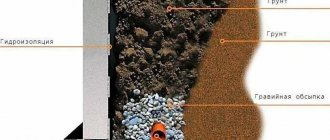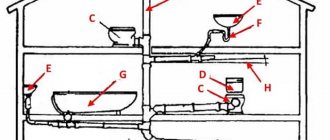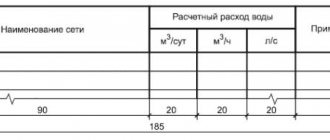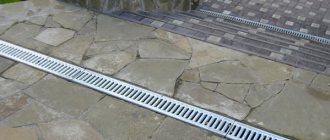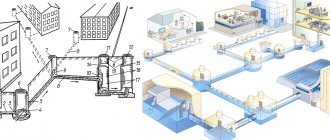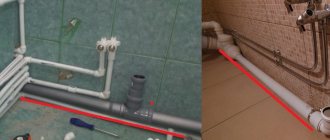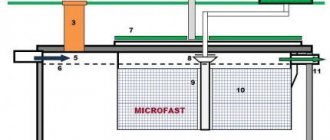assets/from_origin/upload/resize_cache/iblock/3b2/600_450_2/3b2289b0b21fe470e16346fb9bc0e588.jpg From this article you will learn:
- What is a wastewater drainage system?
- What types of wastewater drainage systems are there?
- How to properly install and operate a wastewater sewer system
The wastewater sewage system is a network of utilities and equipment necessary for the improvement of residential and industrial facilities. The sewer system is installed in accordance with sanitary and hygienic standards and is designed to ensure a high quality of life for the population.
Wastewater sewer system: basic concepts
Sewerage includes a whole complex of engineering networks and equipment participating in a single technological process and intended for joint or separate removal of water used by the population, enterprises or agricultural facilities. Through the sewerage system, wastewater is transported beyond the boundaries of residential areas or industrial enterprises to treatment plants for the purpose of their gradual purification from pollution and foreign particles, disinfection and return to water basins or for reuse (for example, in production).
Sewage facilities – these are residential and public facilities, industrial buildings, equipped with an internal water supply and drainage system and sewerage system:
|
The wastewater sewage system consists of internal and external sewer networks. The first collects wastewater generated as a result of economic activities and discharges wastewater into the external sewerage system. In turn, the latter delivers them to cleaning stations, where the process of disinfection takes place. Subsequently, wastewater that has undergone processing steps is returned to the reservoir without disturbing its natural environment.
It is customary to call waste water used in everyday life and production. They have different origins, as well as the content of chemical elements and impurities. Based on their qualitative characteristics, they are classified into domestic, obtained in the process of human activity, storm water formed as a result of rainfall, snowmelt, street watering, and industrial - technical water used in enterprises. Accordingly, each type has its own drainage system.
- Domestic wastewater
Domestic wastewater is considered to be household wastewater generated as a result of human activity. They are formed in residential and public buildings and commercial and industrial premises. Household water is considered to be contaminated water from kitchens and toilets, baths, laundries, catering outlets, medical institutions, as well as water generated during wet cleaning of premises.
- Industrial wastewater
This type includes waters involved in technological production processes, the level of pollution of which no longer meets the required standards. Such water is removed from the territory of enterprises and delivered to treatment plants through the wastewater sewer system. Industrial waters include drainage waters pumped out during the development of natural resources (coal, oil, minerals, etc.).
- Rain and melt water
These are atmospheric runoff that is created during the process of precipitation and snowmelt. Their number is determined by weather conditions and the amount of precipitation, which may vary during the season. They contain mineral and organic compounds. Together with rainwater, drainage, which has a similar qualitative composition of impurities, and wastewater after watering and washing streets are discharged through storm sewers.
Arbitrage practice
Perhaps the main argument in favor of the importance of discussing in detail the boundaries of operational responsibility in a resource supply agreement will come from examples from judicial practice.
Managing organization
filed a lawsuit to declare the terms of energy supply contracts invalid and to order the obligation to transfer heating networks to the area of responsibility of the RSO. The court refused to satisfy the claims, since the Criminal Code agreed on the boundaries of the balance sheet, accepting the disputed section of the networks for its maintenance (Resolution of May 23, 2012 in case No. A63-9362/2011).
The court may make a different decision if the boundaries of the balance sheet in the act are indicated differently than along the external wall of the apartment building
or at the installation point of the metering device. In this case, the act of delimiting balance sheet ownership is invalid (Determination of the Supreme Arbitration Court of the Russian Federation dated June 26, 2012 N 6421/12 in case N A14-11374/2010).
When concluding the contract, disagreements arose between the parties regarding the limit of operational responsibility, since there was no act of delimitation of responsibility, the court decided to determine the limit of operational responsibility in accordance with the Rules for the maintenance of common property
(Resolution of the Arbitration Court of the Central District dated May 21, 2015 N F10-1143/2015 in case N A68-2267/2014).
And according to the FAS Decree UO dated February 28, 2011 No. Ф09-443/11-С5, in a similar situation, there is no demarcation of responsibility concluded
the court concluded that the line of operational responsibility should run along the line of balance sheet ownership, in other words, along the line of division of utility networks between the owners.
If you have any questions, you can always contact us for advice. We also help management companies comply with 731 Russian Federation Regulations on the Information Disclosure Standard
(filling out the
housing and communal services reform
, the management company website, information stands) and Federal Law No. 209 (). We are always happy to help you!
General classification of wastewater drainage systems
Sewerage is classified into several types, depending on the tasks assigned to drainage, as well as the degree and nature of wastewater pollution.
Wastewater is received into the rainwater (storm) sewerage system after rain and snow melting. Sewage uncontaminated by industrial waste is discharged into the industrial rainwater drainage system.
The domestic wastewater sewerage system receives and discharges wastewater of the same name - domestic.
Only contaminated process water from industrial enterprises is transported through the industrial sewerage network. This is an autonomous sewerage network.
The industrial and household network receives wastewater into the sewerage system from domestic and industrial sources. Such communications are installed if they do not disrupt the operation of the network and treatment facilities.
The wastewater sewer system, through which all categories of waste are transported, is called a general alloy system. Through a single, common sewer system, domestic, industrial and rainwater are discharged outside residential areas for their purification to standard levels.
Separate systems are those in which rainwater and contaminated water from industrial enterprises are discharged through an independent drainage system, and domestic and contaminated industrial wastewater is discharged through another collector or several networks.
A separate sewerage system can be complete or incomplete.
A complete separate system includes two or more independent wastewater sewer systems, each of which transports only a specific type of wastewater:
- network exclusively for rainwater or industrial rainwater;
- a network for the drainage of domestic and partially contaminated industrial waters permitted to be discharged into the domestic sewer system;
- a network through which industrial waters are discharged, the degree of contamination of which does not allow them to be transported together with household water.
An incomplete separate sewage system is a sewage system intended only for extremely polluted industrial and domestic waters.
With such a system, atmospheric waters flow by gravity into a natural reservoir or ravine along slopes and ditches, along ditches and thalwegs.
As a type of combined and separate systems, there are semi-separate and combined wastewater sewage systems.
A semi-separate sewer system is a complex of separate sewer systems with one main (intercepting) sewer. Its purpose is to transport domestic, industrial, melt waste, as well as water formed after washing streets and especially contaminated atmospheric waters to treatment plants.
Combined sewer systems are a combination of combined and separate sewer systems. Their formation is explained by the growth of cities with a common sewage system. Taking into account the partial load of the common sewerage system (in the absence of precipitation it is not used), it was connected to the domestic and industrial sewerage network from new buildings. And atmospheric water began to be discharged directly without treatment into natural reservoirs using independent storm collectors.
This is how a combined sewer system was formed, in which some areas of the city retained a general sewer system, others were equipped with a separate system, and others were equipped with an incomplete separate system.
Typical problems
Typical problems with indoor wiring are blockages and depressurization of connections, which will be indicated by an unpleasant odor in the premises and leaks. The blockage can be removed with fat-decomposing chemicals and mechanically - by pushing accumulated deposits in the pipes with a plunger or destroying them with a special wire stack (cable). Rubber cuffs, installation of new seals, additional sealing of joints (for example, with FUM tape), and re-caulking of the socket (for cast iron pipes) help eliminate the cause of the smell.
A water seal at each drain point also becomes a barrier to odors. This is a lowering of the drain pipe in the shape of the English letter U, in which water constantly remains - it completely blocks the internal cross-section of the duct over the entire area. In bidets and toilets, such a seal is based on the shape of the products themselves. Siphons are installed on drains from sinks, bathtubs and showers. For a flexible corrugated drain, the water seal is made in place manually, the U-shaped section is fixed with rigid wire. There is no need for a water seal in front of dishwashers and washing machines. Its role is played by a check valve built into each product.
The rules for using sewerage in an apartment building for residents prohibit:
- Using water in excess of personal needs.
- Operation of faulty taps.
- Discharge of construction waste, food debris, metal, glass and wooden elements, fuels and lubricants, aggressive chemical compounds and other materials into the sewer system.
- Use of the system until any violation in its operation is eliminated.
What to consider when choosing a wastewater sewer system for a private home
When planning communications in a residential building, select in advance the type of wastewater drainage system that is convenient for you. In the absence of a centralized sewer system or the possibility of connecting to it, the optimal solution would be to build a local sewer system.
First, we set up a cesspool. Calculate the costs for each type of system that can be placed on the site, and you will see that this is the most budget option. As a result, financing the construction of any treatment facility will exceed the costs of a drainage pit. In addition, the cesspool will last you up to 5 years; a septic tank lasts from 10 to 12 years, and if you equip it with biofilters, it can serve regularly for up to several decades.
Recommended articles on this topic:
- Major renovation of a private house: work procedure and useful tips
- Electrics in a cottage: rules and recommendations
- Installation of automatic gates: work procedure and useful tips
Whereas the construction of a high-quality sewer system will require a lot of cash injections from you. It will be necessary to conduct a geological survey of the site and plan the costs of construction materials and payment for installation of equipment. But they are more than compensated by the absence of a not very pleasant smell accompanying sewage, and the need for regular cleaning of local sewage systems.
So when arranging a sewer system for a private home, consider all existing wastewater sewer systems. At the same time, remember that sometimes it is worth overpaying for fresh air and the absence of worries associated with the rules of arrangement and operation.
Initial data for design
The initial data for the designer is:
- Technical specifications of the customer, defining the purpose of the object, technical characteristics, quality indicators, technical and economic requirements.
- Technical conditions for connecting the designed structures to existing networks, issued by the owner of communications.
- A report on engineering-geological and hydrogeological surveys provided by the project customer.
- Geodetic base, topographic survey on a scale of 1:500.
- Architectural and planning sections of the project.
The result of the design is the development of a design solution that will ensure uninterrupted operation of the drainage system.
Which wastewater drainage system for a private home to choose
Wastewater treatment systems for private homes are divided into several main groups.
- Storage containers
Storage tanks are capacious tanks that are installed underground and equipped with access to the surface, providing free access for pumping out accumulated masses. Storage tanks can be made of various materials, but the most common are sealed metal tanks or plastic Eurocubes in a protective metal mesh.
In addition, containers made of concrete rings that are installed on a concrete bottom are also considered reliable. To create a sealed well, cracks, joints and technological holes are carefully sealed so that wastewater does not leak through them into the ground. The structure will be monolithic if the container is poured right on the spot - gradually laying out the walls of the dug pit with concrete. In this case, neither transportation of the rings nor installation work will be required.
Despite their strength, simplicity and reliability, concrete structures are not in great demand among consumers. Mainly due to the need to regularly pump out contents.
This work is performed by special sewage disposal machines. They are equipped with powerful vacuum pumps and large tanks that allow you to clean sewer tanks in a matter of minutes. This operation is carried out from one to three times a year, depending on the volume of the tank and the number of people using the drains. So this procedure will have to be repeated regularly, which makes the use of storage tanks for wastewater quite unprofitable.
Another disadvantage is the destruction of the structure under the influence of an aggressive environment, the risk of soil contamination by sewage and seepage of wastewater into reservoirs used for water intake.
This especially applies to metal structures that are susceptible to corrosion. Regardless of the treatment with protective compounds and the quality of the alloys, corrosion reactions are inevitable. Under the influence of the external environment and the internal influence of chemical components contained in detergents entering the tank, the walls of the tank become thinner. And monitoring the condition of a container buried several meters underground is practically impossible except by removing it from the ground.
Concrete tanks are less susceptible to corrosion in this regard, but they also deteriorate over time.
These materials compete with plastic containers. That's who is not afraid of corrosion. And if you take all protective measures during installation, protecting the tank from external mechanical and physical influence, it can serve forever. There is still one drawback - plastic containers are inferior in size to their iron counterparts. But technology does not stand still, and every year tanks that are much larger than their predecessors and comparable in strength to iron ones come onto the market.
- Single-chamber septic tanks
There are two types of single-chamber structures. An economical option is a drainage well that does not have a bottom. Instead, sand and gravel are placed in a built-in container, which are used as a filter in this wastewater treatment system. Sewerage, made of concrete rings installed one on top of the other in a dug pit, is considered the most reliable among inexpensive single-chamber septic tanks. To protect the soil and surrounding flora, careful sealing of the joints between the rings is required.
So it is preferable to install single-chamber septic tanks at a point with the lowest groundwater level. Otherwise, partially purified water and dirt that seeped through a small layer of soil can contaminate underground sources.
Metal containers with large holes in the bottom designed to drain wastewater can also be used as single-chamber septic tanks.
The most suitable solution for a single-chamber septic tank is a sealed tank with access to the filtration fields or an infiltrator. With its help, it is possible to create a productive wastewater sewage system without the risk of environmental pollution. The design of such a septic tank is quite simple, so you can make it yourself or purchase an industrial one.
Domestic wastewater is discharged into the sewerage system, then the wastewater is sent to a single-chamber tank. Any material is suitable for a sealed single-chamber container. It is more practical to make it from concrete rings. To prevent contaminated wastewater from entering the soil, they are installed on a concrete stand. Such a container acts as a sump; solid insoluble dirt particles will settle to the bottom, and lighter suspensions, including fatty and chemical particles, will collect at the upper level.
The interlayer water separated in this way is discharged through an overflow pipe to filtration fields or an infiltrator, which are the final stage of the wastewater treatment system in the sewer system, then the purified water is discharged into the ground. The infiltrator acts as a mechanical filtration field and works as a natural sand and gravel filter. For better water purification, large areas are covered with the mixture, distributing wastewater evenly over it.
Industrial infiltrators may have a collection system to drain wastewater not into the ground, but into nearby drains. From single-chamber septic tanks, it is necessary to regularly pump out solid waste and activated sludge from the septic tank. And as they become polluted and silted during operation, do not forget to change the sand and gravel. Another disadvantage of such a system is that there are strict requirements for the installation of sewerage with drainage into the soil.
- Multi-chamber septic tanks
An effective solution for discharging wastewater into the sewer system for a private home are structures with several tanks connected to each other by overflow pipes. To install this type of septic tank, you will need 2-3 metal, plastic or concrete sealed tanks. For more productive operation of such a wastewater sewage system, auxiliary mechanical filters and grease traps are installed in the overflow pipes.
In the first two settling tanks, the process of settling wastewater occurs. When compared with single-chamber septic tanks, here the process occurs at a higher level.
The first container contains a biological filter - special aerobic bacteria that accelerate the process of fermentation and decomposition of human waste products. And if their relatives - anaerobic bacteria - are ready to work and digest organic matter without fresh air, then for the development of aerobic microorganisms a constant flow of oxygen is simply necessary, so ventilation equipment is required here. Its design and power directly depend on the size of the tanks and the amount of wastewater.
Ventilation can have either a natural air flow or a forced oxygen injection system. But there is a catch here too. For microorganisms that accelerate the decomposition of organic matter, forced ventilation, providing a uniform air flow, is an advantage. Whereas for the user himself, the volatility of the ventilation system is a flaw. In the event of a power outage, the flow of oxygen may stop, which can lead to the death of aerobacteria.
After moving through settling chambers and bacterial treatment, wastewater is supplied to an infiltrator or aeration fields, which are also installed in the ground. It is worth considering that it is not recommended to plant fruit-bearing plants a few meters from the system with aeration and filtration fields. There is always a risk that harmful substances contained in wastewater will be absorbed through the root system and enter the fruit, and from there into the human body. This can lead to intoxication and even poisoning of the body.
In an infiltrator with a plastic dome, this situation is excluded, since the purified water is discharged deep underground. The only problem may be the powerful root system of trees growing nearby, which can damage the container.
- Biological treatment stations
With the help of biological stations, you can obtain deeply purified water, suitable for reuse in everyday life (for wet cleaning, watering plants, etc.).
The design of biological stations is similar to multi-chamber septic tanks, but thanks to a more complex organization of work, providing an autonomous principle of a stage-by-stage wastewater treatment system, sewerage has significant advantages: higher productivity when receiving wastewater into the sewerage system and a high degree of purification.
In the first compartment, water settles: sedimentation of solid particles and separation of fatty components. Having passed the first stage of purification, the discharged water undergoes the process of aeration - saturation with oxygen. Next, the wastewater enters a chamber with activated biological sludge, saturated with aerobic microflora, which accelerates the process of decomposition of organic matter. At the final stage, the water undergoes chemical treatment, destroying all bacteria.
All of the above processes - overflows, oxygen saturation and a forced ventilation system - are controlled automatically, which requires an uninterrupted supply of electricity. Biological treatment plants show the greatest efficiency in wastewater treatment, but are also one of the most expensive methods. This is why it is not very popular among ordinary users. Often biological stations set up a pooling arrangement. The equipment easily serves several residential properties located nearby.
There are practically no restrictions on the installation of biological treatment stations. The tightness of the tanks and deep water purification eliminate even accidental pollution of the environment.
In cold areas, in order to avoid the death of aerobacteria, it is recommended to insulate the foundation pit for the biological station.
Biological treatment stations
Among the most common energy-dependent biological treatment stations are brands such as Topas, Topaero, Topol, Ecoros, Deka, Biopurit and others.
These systems have good characteristics, but they depend on quality service and are capricious: often only representatives of the manufacturing company or companies specializing in installing these structures can work with these systems. The owners of biological treatment stations themselves can also engage in their maintenance, but very carefully: if you have the slightest doubt, you need to contact professionals so as not to damage the linear drainage system with your actions.
What is a vacuum wastewater drainage system?
A wastewater sewage system, where waste is transported due to pressure differences in different parts of the network, is called vacuum. This system is in less demand among owners of private houses.
When wastewater is discharged into the sewer system, it is collected in a storage tank. As soon as it is filled to the required volume, the vacuum valves open. The air pumped into the system pushes wastewater at high speed towards a completely sealed storage manifold.
The reservoir is a component of the pumping station. Installation of the tank is allowed both underground and on its surface. The power of the equipment that pumps wastewater to the place of its treatment is calculated individually for each station. The system is controlled through a hardware-software module.
The reliability of this installation depends on the reliability of the equipment used at the station. Therefore, purchase it only from reliable suppliers who have certificates confirming the quality of the equipment.
Today, vacuum sewer systems are made of plastic with the addition of mixtures that increase the strength of the composition.
The vacuum system has the following advantages:
- during installation it is allowed to use pipes of small diameter (from 80 to 200 mm);
- the external system can be safely buried at shallow depths;
- sewerage is suitable for land plots with complex terrain;
- can be operated even when groundwater flows close to the surface;
- can be installed on an area with soils that are difficult to develop.
Internal operational boundaries
The boundary of operational responsibility between the management company and the owners when it comes to the internal boundary of utility networks that are part of the common property
MKD are:
- for heating - valves on the heating pipeline connections to the apartment radiator. If there are none, then the boundary passes along the threaded connection in the radiator plug.
- for cold and hot water supply - a valve at the pipeline outlet from the riser. If it is not available, the boundary is the weld seam at the pipeline outlet from the riser.
- for drainage - a socket of a shaped product (tee, cross, bend) on the riser of the drainage pipeline.
- for power supply - the place where the outgoing wire of the apartment electrical wiring is connected to the plug of an individual electricity meter, circuit breaker, RCD.
The boundary of operational responsibility between management companies
and the owners (we are talking about the internal border of building structures that are part of the common property of an apartment building) are the inner surface of the walls of the apartment, window fillings and the entrance door to the apartment.
The enclosing load-bearing structures, the land plot (including children's and playgrounds, collective parking lots) on which the house is located, landings, corridors, roofs and attics, as well as elevators are in the area of operational responsibility
UK.
